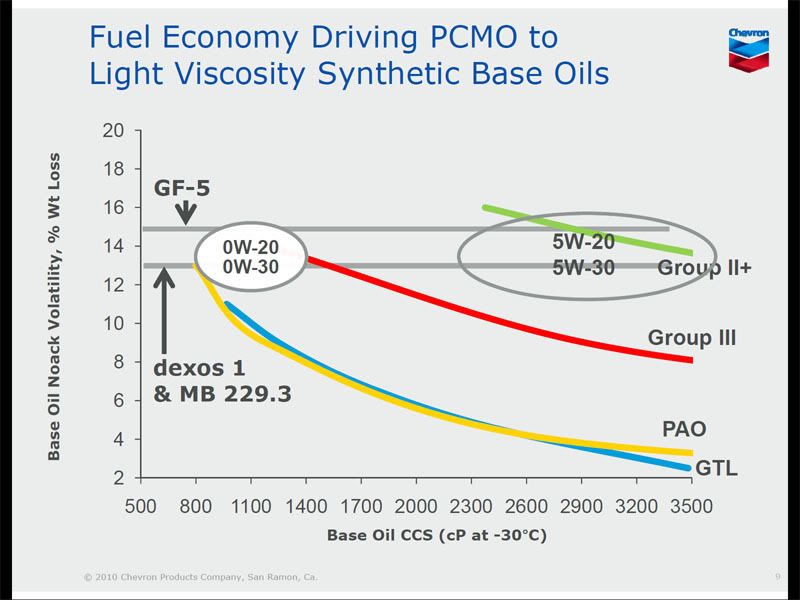Originally Posted By: Gokhan
Originally Posted By: carwreck
Examples of Group III base oils with low NOACK, ATSM D5800:
Shell low NOACK Group III "XHVI" 5%
http://www.epc.shell.com/Docs/GPCDOC_GTDS_XHVI_8.2.pdf
Chevron low NOACK Group III "UCBO 7R" with Evaporative Loss, NOACK (ATSM D5800) of 4:
http://www.chevron.com/products/sitelets/baseoils/Documents/PDF/GroupIII_download_r4.pdf
__________________________________________
1987 Toronado
1999 Olds GLS
Thanks for the references.
The problem isn't that you can't have low NOACK with Group III/III+. The problem is that you can't have low NOACK and low CCS at the same time. These low-NOACK Group III oils can be used in the formulation of 15W-xx and perhaps 10W-xx oils but not in the formulation 5W-xx or 0W-xx oils as a result. if you look at the Chevron specs, it says N/A under -30 C CCS, which means in cannot be used for 5W-xx or 0W-xx.
See this graph again on how NOACK and CCS determine the base-oil selection for various viscosity grades:

Therefore, you can't have a 0W-xx or a 5W-xx with NOACK less than about 8 unless you use PAO and GTL in the mix. According to the NOACK values from the official Shell product datasheet, Pennzoil Ultra almost certainly has more than half PAO and/or GTL in the base-oil mix. Amsoil Signature series has higher NOACK; so, it probably has much less PAO/GTL. Mobil 1 seems to be mostly Group III according to NOACK; although their 0W-xx formulations seem to have more PAO than other formulations because of their very low MRV (as very low MRV would still require PAO despite higher NOACK according to the above graph).
The graph in your post is a representation of D5293 (CCS at low temperature -30°C ) combined with Noack.
The previous page in the presentation shows Group III 5w30 Noack 5% with CCS cP@-20 °
Full presentation http://www.api.org/certifications/engine...ril_20_2010.pdf
The problem with this graph as it relates to Pennzoil: It is not the D5800 spec shown on the Pennzoil pds. http://www.epc.shell.com/Docs/GPCDOC_X_cbe_24855_key_140006587313_201112051449.pdf
CCS and Noack and not measured at the same time in the GF-5 spec.
ASTM D5293 Cold Cranking is measured at low temperature http://www.astm.org/Standards/D5293.htm
The actual D5800 spec does not have any CCS parameter and is measured at 250°C
http://www.api.org/certifications/engineoil/new/upload/1509techbull1complete.pdf
D5800 lab test procedure http://www.swri.org/4org/d08/GasTests/ilsacGF5.pdf
Originally Posted By: carwreck
Examples of Group III base oils with low NOACK, ATSM D5800:
Shell low NOACK Group III "XHVI" 5%
http://www.epc.shell.com/Docs/GPCDOC_GTDS_XHVI_8.2.pdf
Chevron low NOACK Group III "UCBO 7R" with Evaporative Loss, NOACK (ATSM D5800) of 4:
http://www.chevron.com/products/sitelets/baseoils/Documents/PDF/GroupIII_download_r4.pdf
__________________________________________
1987 Toronado
1999 Olds GLS
Thanks for the references.
The problem isn't that you can't have low NOACK with Group III/III+. The problem is that you can't have low NOACK and low CCS at the same time. These low-NOACK Group III oils can be used in the formulation of 15W-xx and perhaps 10W-xx oils but not in the formulation 5W-xx or 0W-xx oils as a result. if you look at the Chevron specs, it says N/A under -30 C CCS, which means in cannot be used for 5W-xx or 0W-xx.
See this graph again on how NOACK and CCS determine the base-oil selection for various viscosity grades:

Therefore, you can't have a 0W-xx or a 5W-xx with NOACK less than about 8 unless you use PAO and GTL in the mix. According to the NOACK values from the official Shell product datasheet, Pennzoil Ultra almost certainly has more than half PAO and/or GTL in the base-oil mix. Amsoil Signature series has higher NOACK; so, it probably has much less PAO/GTL. Mobil 1 seems to be mostly Group III according to NOACK; although their 0W-xx formulations seem to have more PAO than other formulations because of their very low MRV (as very low MRV would still require PAO despite higher NOACK according to the above graph).
The graph in your post is a representation of D5293 (CCS at low temperature -30°C ) combined with Noack.
The previous page in the presentation shows Group III 5w30 Noack 5% with CCS cP@-20 °
Full presentation http://www.api.org/certifications/engine...ril_20_2010.pdf
The problem with this graph as it relates to Pennzoil: It is not the D5800 spec shown on the Pennzoil pds. http://www.epc.shell.com/Docs/GPCDOC_X_cbe_24855_key_140006587313_201112051449.pdf
CCS and Noack and not measured at the same time in the GF-5 spec.
ASTM D5293 Cold Cranking is measured at low temperature http://www.astm.org/Standards/D5293.htm
The actual D5800 spec does not have any CCS parameter and is measured at 250°C
http://www.api.org/certifications/engineoil/new/upload/1509techbull1complete.pdf
D5800 lab test procedure http://www.swri.org/4org/d08/GasTests/ilsacGF5.pdf
Last edited:

